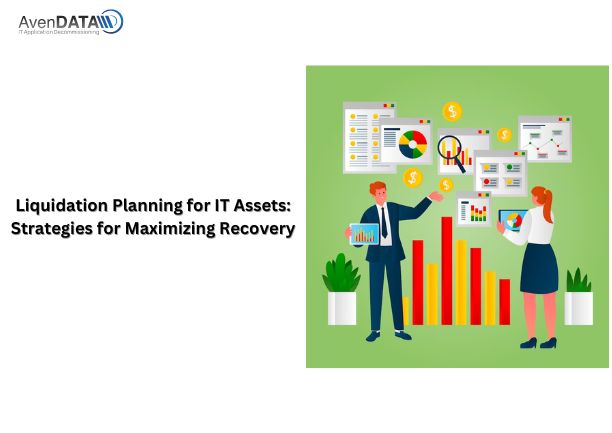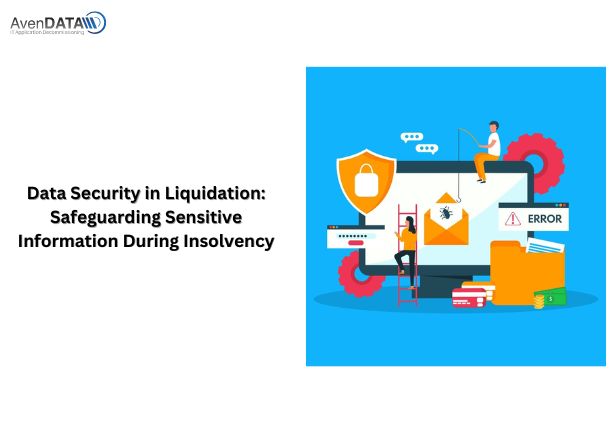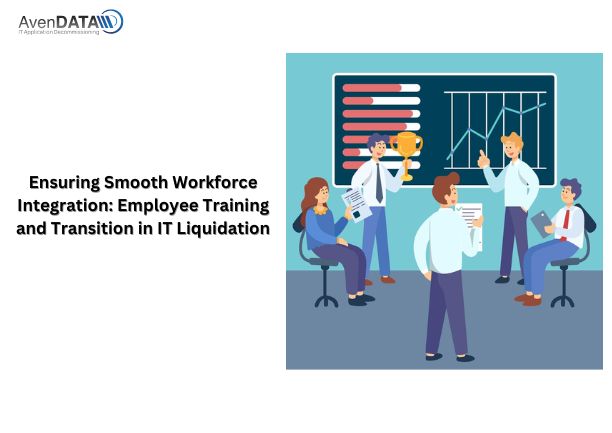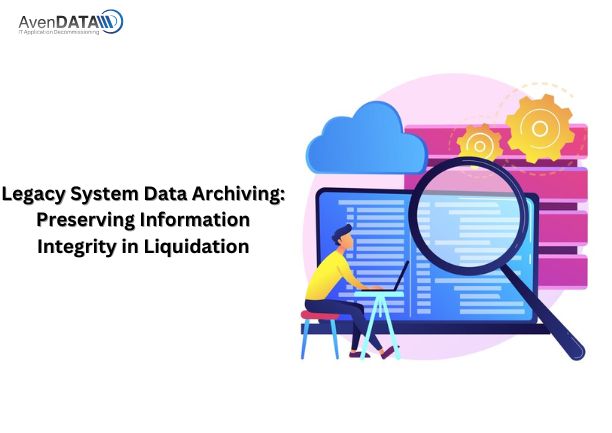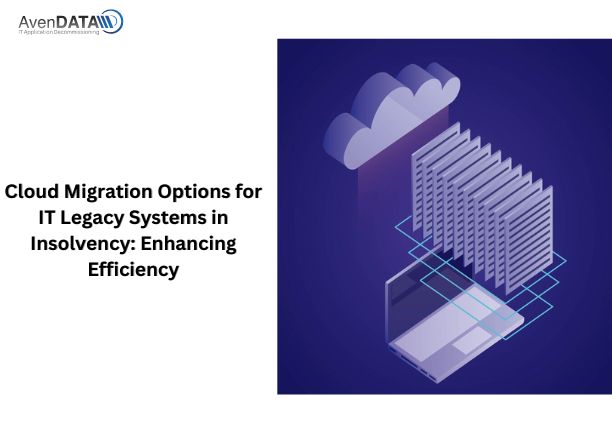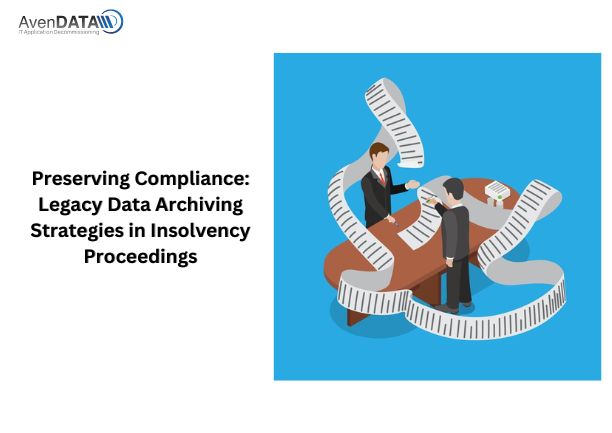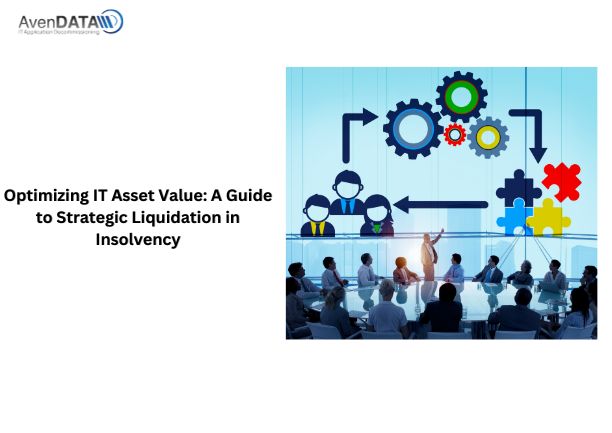In the corporate landscape, liquidation is an inevitable reality that businesses may face due to various factors such as financial distress, restructuring, or market shifts. When navigating the proces... View MoreIn the corporate landscape, liquidation is an inevitable reality that businesses may face due to various factors such as financial distress, restructuring, or market shifts. When navigating the process of liquidation, one of the critical areas of concern is managing IT assets effectively. From hardware to software licenses, these assets hold significant value, and maximizing recovery during liquidation requires careful planning and execution. In this blog post, we’ll delve into key strategies for liquidation planning specifically tailored to IT assets.
1. Conduct a Comprehensive Inventory: Before embarking on liquidation, it’s crucial to conduct a thorough inventory of all IT assets within the organization. This includes hardware components such as servers, networking equipment, and computers, as well as software licenses, subscriptions, and intellectual property rights. A comprehensive inventory provides clarity on the assets available for liquidation and helps in assessing their market value.
2. Evaluate Asset Utilization and Condition: Assessing the utilization and condition of IT assets is essential for determining their resale value. Assets that are in good working condition and have been well-maintained are likely to fetch higher prices in the secondary market. Conversely, outdated or obsolete equipment may have limited resale value and may need to be disposed of through environmentally responsible means.
3. Prioritize Asset Recovery: Not all IT assets hold the same value, and prioritizing recovery efforts can help maximize returns during liquidation. Identify high-value assets that are in demand in the secondary market and focus on recovering them first. Additionally, consider the resale potential of software licenses, subscription contracts, and other intangible assets.
4. Explore Liquidation Channels: When liquidating IT assets, organizations have several options for disposal, including auctions, resale vendors, asset recovery firms, and online marketplaces. Each channel offers different advantages and disadvantages in terms of speed, convenience, and potential returns. Evaluate these options carefully to determine the most suitable approach for liquidating your IT assets.
5. Ensure Data Security and Compliance: Data security is paramount during the liquidation process, especially when disposing of hardware that may contain sensitive information. Implement robust data erasure procedures to securely wipe all data from storage devices before resale or disposal. Additionally, ensure compliance with relevant regulations such as GDPR, HIPAA, or industry-specific data protection standards.
6. Negotiate Vendor Contracts: Review existing vendor contracts and agreements related to IT assets, including warranties, maintenance contracts, and software licenses. Explore opportunities to renegotiate or terminate these contracts to reduce ongoing expenses during liquidation. Negotiating favorable terms with vendors can help minimize costs and maximize recovery.
7. Plan for Environmental Sustainability: Sustainable disposal of IT assets is increasingly important for organizations seeking to minimize their environmental footprint. Explore options for recycling or repurposing equipment to extend its lifecycle and reduce electronic waste. Partnering with certified e-waste recyclers ensures compliance with environmental regulations and promotes responsible stewardship of resources.
8. Document the Liquidation Process: Maintain detailed records of the liquidation process, including inventory lists, asset valuations, sales contracts, and disposal certificates. Documentation provides transparency and accountability, which is essential for compliance purposes and potential audits. Keep stakeholders informed throughout the liquidation process to maintain trust and credibility.
In conclusion, effective liquidation planning for IT assets requires careful consideration of factors such as asset valuation, resale channels, data security, and environmental sustainability. By following the strategies outlined above, organizations can maximize recovery, minimize risks, and navigate the liquidation process with confidence and efficiency.
Know more : https://avendata.com/liquidation
#liquidation #insolvency #avendata #legacysystems
Insolvency Impact on IT Legacy Systems: Risks and Opportunities
In the fast-paced world of business, insolvency can strike unexpectedly, posing significant challenges to organizations of all sizes. W... View MoreInsolvency Impact on IT Legacy Systems: Risks and Opportunities
In the fast-paced world of business, insolvency can strike unexpectedly, posing significant challenges to organizations of all sizes. When a company faces insolvency, its IT legacy systems often become a focal point of concern. These systems, which may have been meticulously built and maintained over the years, suddenly face uncertain futures. In this article, we’ll explore the risks and opportunities that insolvency presents for IT legacy systems and how businesses can navigate this challenging terrain.
Risks:
Data Loss: One of the most immediate risks associated with insolvency is the potential loss of valuable data stored within legacy systems. Without proper management and oversight, critical information may be lost or compromised during the liquidation process.
Security Breaches: Insolvency can create vulnerabilities in IT systems, making them more susceptible to security breaches and cyberattacks. Hackers may exploit weaknesses in outdated software or infrastructure, leading to data breaches and financial losses.
Compliance Concerns: Insolvency often triggers a flurry of legal and regulatory obligations, including data protection laws, industry standards, and contractual agreements. Failing to meet these compliance requirements can result in legal repercussions and damage to the company’s reputation.
Operational Disruption: As a company navigates insolvency proceedings, its day-to-day operations may be disrupted, impacting the availability and functionality of IT systems. This disruption can hinder productivity, strain customer relationships, and impede business continuity.
Opportunities:
Modernization Initiatives: Insolvency can provide an opportunity for organizations to reassess their IT infrastructure and explore modernization initiatives. By investing in newer technologies and platforms, businesses can enhance efficiency, agility, and competitiveness.
Cost Optimization: Insolvency forces companies to scrutinize their expenses and identify areas for cost optimization. By decommissioning outdated or redundant IT systems, organizations can reduce maintenance costs and streamline operations.
Data Consolidation: Insolvency often involves consolidating assets and streamlining operations to maximize value. This presents an opportunity for businesses to rationalize their data holdings, consolidate disparate systems, and improve data management practices.
Agile Adaptation: In times of financial distress, companies must be agile and adaptable to survive. Insolvency can prompt organizations to embrace change, innovate new business models, and pivot toward more sustainable practices.
Navigating the Challenges:
Strategic Planning: To mitigate the risks associated with insolvency, organizations must develop strategic plans for managing their IT legacy systems. This includes conducting thorough assessments, identifying critical assets, and prioritizing data protection efforts.
Collaboration and Communication: Effective communication and collaboration between stakeholders are essential for navigating insolvency proceedings. IT teams, legal advisors, and financial experts must work together to address challenges and seize opportunities.
Data Protection Measures: Implementing robust data protection measures is paramount to safeguarding sensitive information during insolvency. This may involve data encryption, access controls, regular backups, and compliance with relevant regulations.
Continuous Monitoring: Insolvency is a dynamic process that requires continuous monitoring and adaptation. Organizations must stay vigilant, anticipate potential risks, and adjust their strategies accordingly to ensure the smooth operation of IT legacy systems.
In conclusion, while insolvency poses significant risks to IT legacy systems, it also presents opportunities for organizations to reassess their technology infrastructure, optimize costs, and embrace innovation. By adopting strategic planning, collaboration, and data protection measures, businesses can navigate the challenges of insolvency and emerge stronger and more resilient in the long run.
Know more : https://avendata.com/liquidation
#liquidation #itliquidation #avendata #legacysystems
Data Security in Liquidation: Safeguarding Sensitive Information During Insolvency
In the fast-paced world of business, companies face various challenges, including financial distress and insolvency.... View MoreData Security in Liquidation: Safeguarding Sensitive Information During Insolvency
In the fast-paced world of business, companies face various challenges, including financial distress and insolvency. When a company enters liquidation, one of the critical considerations is safeguarding sensitive information, including customer data, intellectual property, and proprietary business processes. Failure to secure this data during insolvency can lead to severe consequences, including regulatory penalties, reputational damage, and legal liabilities. In this blog post, we explore the importance of data security in liquidation and provide strategies to safeguard sensitive information effectively.
Identify Sensitive Data: The first step in data security during liquidation is to identify all sensitive data within the organization. This includes customer information, financial records, trade secrets, and any other proprietary data. Conduct a thorough inventory of all data repositories, including databases, servers, and cloud storage, to ensure comprehensive coverage.
Implement Access Controls: Restrict access to sensitive data to authorized personnel only. Implement strong authentication mechanisms, such as multi-factor authentication, and enforce the principle of least privilege to limit access to data based on job roles and responsibilities. Regularly review and update access permissions to ensure compliance with security policies.
Encrypt Data: Encrypting sensitive data at rest and in transit adds an extra layer of protection against unauthorized access. Utilize robust encryption algorithms to encrypt data stored on servers, databases, and storage devices. Additionally, implement secure communication protocols such as SSL/TLS to encrypt data during transmission over networks.
Secure Data Destruction: Properly dispose of data that is no longer needed or relevant to the liquidation process. Utilize secure data destruction methods such as data wiping or degaussing for physical storage devices, and implement secure deletion techniques for digital data. Document the data destruction process to demonstrate compliance with data protection regulations.
Monitor Data Access and Usage: Implement robust logging and monitoring mechanisms to track data access and usage during the liquidation process. Monitor user activity, file access, and data transfers to detect any unauthorized or suspicious behavior. Promptly investigate and respond to security incidents or anomalies to prevent data breaches.
Comply with Data Protection Regulations: Ensure compliance with relevant data protection regulations such as GDPR, CCPA, and HIPAA, even during the liquidation process. Understand the legal requirements for data handling, retention, and disposal in each jurisdiction where the company operates. Engage legal experts to navigate complex regulatory frameworks and mitigate compliance risks.
Establish Data Transfer Agreements: If transferring sensitive data to third parties during liquidation, establish clear data transfer agreements to outline data security and privacy obligations. Ensure that third-party recipients adhere to stringent security standards and implement appropriate safeguards to protect transferred data.
Educate Employees: Provide comprehensive training and awareness programs to employees involved in the liquidation process. Educate them about data security best practices, the importance of safeguarding sensitive information, and their role in preventing data breaches. Empower employees to identify and report security incidents promptly.
Prepare a Data Breach Response Plan: Develop a detailed data breach response plan outlining steps to be taken in the event of a security incident. Define roles and responsibilities, establish communication protocols, and outline procedures for containing and mitigating the impact of a data breach. Regularly test and update the response plan to ensure readiness.
Engage Data Security Experts: Consider engaging data security experts or external consultants with expertise in data protection and cybersecurity to assist in the liquidation process. Leverage their knowledge and experience to implement robust security controls, conduct risk assessments, and address any security vulnerabilities effectively.
In conclusion, data security is paramount during the liquidation process to protect sensitive information from unauthorized access, breaches, and misuse. By identifying sensitive data, implementing access controls, encrypting data, and adhering to data protection regulations, companies can safeguard their data integrity and maintain trust with stakeholders even in times of financial distress. With comprehensive security measures and proactive risk management, businesses can navigate liquidation proceedings securely and mitigate potential data security risks effectively.
Know more : https://avendata.com/liquidation
#liquidation #avendata #legacysystems #itliquidation
Ensuring Smooth Workforce Integration: Employee Training and Transition in IT Liquidation
The liquidation of IT legacy systems is a complex undertaking that extends beyond technological aspects. One ... View MoreEnsuring Smooth Workforce Integration: Employee Training and Transition in IT Liquidation
The liquidation of IT legacy systems is a complex undertaking that extends beyond technological aspects. One of the critical elements often overlooked is the seamless integration of the workforce during this transitional phase. In this blog, we will explore the importance of employee training and transition strategies in IT liquidation, outlining key practices to ensure a smooth and efficient process.
Recognizing the Human Element in IT Liquidation
While technology plays a central role in the liquidation of IT legacy systems, it’s crucial not to underestimate the impact on employees. Recognizing the human element in the process is the first step toward ensuring a successful transition. We will delve into the psychological aspects of change management, emphasizing the importance of clear communication, empathy, and transparency.
Communication Strategies for Workforce Transition
Clear and transparent communication is the cornerstone of successful workforce transition during IT liquidation. This section will explore effective communication strategies, including town hall meetings, one-on-one sessions, and comprehensive documentation. We’ll discuss how organizations can keep employees informed about the reasons behind the liquidation, the anticipated changes, and the support available to them throughout the process.
Tailored Training Programs for Skill Transition
As the IT landscape evolves, so do the skill requirements. In the context of liquidation, employees may need to transition to new roles or adapt their existing skill sets. This part of the blog will discuss the importance of tailored training programs designed to equip employees with the skills needed in the post-liquidation environment. We will explore various training methodologies, including workshops, online courses, and mentorship programs.
Addressing Employee Concerns and Fears
Employees often harbor concerns and fears during times of change, especially in situations like liquidation. Here, we will address common concerns employees might have, such as job security, future career paths, and the impact on their daily work routines. We’ll outline proactive measures organizations can take to alleviate these concerns and foster a positive outlook among employees.
Creating a Supportive Work Environment
Maintaining a supportive work environment is instrumental in ensuring workforce integration during IT liquidation. This section will discuss strategies for creating a supportive atmosphere, including employee assistance programs, peer support networks, and leadership accessibility. We’ll highlight the role of leadership in fostering a positive culture that encourages collaboration and adaptability.
Continuous Feedback and Improvement
Feedback loops are crucial in gauging the success of workforce integration efforts. We’ll explore the importance of continuous feedback mechanisms, such as surveys, focus groups, and individual feedback sessions. This iterative process allows organizations to identify areas of improvement and adjust their strategies accordingly.
Case Studies: Successful Workforce Integration in IT Liquidation
The blog will feature case studies showcasing organizations that successfully navigated workforce integration during IT liquidation. These real-world examples will provide insights into the diverse approaches organizations can take, illustrating the positive outcomes of prioritizing employee training and transition.
Looking Ahead: Post-Liquidation Employee Support
The final section will discuss the importance of ongoing support for employees post-liquidation. By providing continued assistance, organizations can help employees adapt to their new roles and contribute to the long-term success of the business.
In conclusion, “Ensuring Smooth Workforce Integration: Employee Training and Transition in IT Liquidation†emphasizes the human side of IT liquidation and offers actionable insights for organizations aiming to prioritize the well-being and professional development of their workforce during this transformative process.
Know more : https://avendata.com/liquidation
#liquidation #itliquidation #avendata
In the dynamic landscape of information technology, businesses are constantly challenged to adapt, innovate, and upgrade their systems. Legacy system data archiving has emerged as a crucial aspect of ... View MoreIn the dynamic landscape of information technology, businesses are constantly challenged to adapt, innovate, and upgrade their systems. Legacy system data archiving has emerged as a crucial aspect of this evolution, particularly when it comes to the liquidation process. This blog explores the significance of legacy system data archiving in preserving information integrity during liquidation and outlines key strategies for a seamless transition.
Understanding Legacy System Data Archiving
Legacy system data archiving involves the systematic storage and retrieval of historical data from outdated or obsolete systems. In the context of liquidation, this process is essential for maintaining the integrity of valuable information accumulated over the years. We’ll delve into the purpose and benefits of legacy system data archiving, emphasizing its role in ensuring a smooth transition during liquidation.
Preserving Data Integrity in Liquidation
As businesses transition away from legacy systems, preserving the integrity of data becomes paramount. This section will discuss the potential risks associated with data loss or corruption during the liquidation process. We’ll outline best practices and methodologies for legacy system data archiving that guarantee the preservation of data integrity, preventing the loss of critical information.
Strategies for Seamless Data Archiving
The blog will provide a comprehensive overview of strategies businesses can employ for seamless data archiving during liquidation. This includes data categorization, prioritization, and the use of advanced archiving tools to streamline the process. Real-world examples and case studies will be incorporated to illustrate successful data archiving strategies in diverse business scenarios.
Data Privacy and Security Considerations
Given the increasing emphasis on data privacy, businesses must navigate the liquidation process with a keen eye on security. We’ll address the data privacy and security considerations associated with legacy system data archiving, providing insights into compliance with regulations and safeguarding sensitive information throughout the liquidation journey.
Choosing the Right Archiving Solutions
Selecting the right archiving solutions is a critical decision in the liquidation process. This section will explore various archiving tools, technologies, and platforms available in the market. We’ll discuss the criteria for choosing the most suitable solution based on business needs, scalability, and future data retrieval requirements.
Case Studies: Successful Data Archiving in Liquidation
To illustrate the effectiveness of legacy system data archiving, the blog will feature case studies highlighting businesses that successfully preserved information integrity during the liquidation process. These examples will serve as practical insights for organizations contemplating similar initiatives.
Future-Proofing with Archived Data
The final section of the blog will focus on the long-term benefits of legacy system data archiving. By future-proofing data through strategic archiving, businesses can leverage historical information for analytics, compliance, and strategic decision-making even after the liquidation is complete.
In summary, “Legacy System Data Archiving: Preserving Information Integrity in Liquidation†aims to guide businesses through the intricate process of archiving data from legacy systems, ensuring a smooth and secure transition during the liquidation phase.
Know more : https://avendata.com/liquidation
#liquidation #itliquidation #avendata #legacysystems
Navigating the Legal Landscape: A Guide to IT Legacy Systems Liquidation Compliance
In the fast-evolving landscape of IT, businesses often find themselves faced with the challenging task of liquidati... View MoreNavigating the Legal Landscape: A Guide to IT Legacy Systems Liquidation Compliance
In the fast-evolving landscape of IT, businesses often find themselves faced with the challenging task of liquidating legacy systems. This process, while essential for staying agile and competitive, is intricately tied to legal considerations that demand careful navigation. In this blog, we’ll explore the vital aspects of IT legacy systems liquidation compliance, providing businesses with a comprehensive guide to ensure a smooth and legally sound transition.
Understanding the Legal Imperatives
The first step in navigating IT legacy systems liquidation is gaining a deep understanding of the legal imperatives surrounding this process. We’ll delve into compliance requirements, regulatory frameworks, and the legal principles that govern the responsible and lawful liquidation of IT assets.
Compliance Requirements in IT Legacy Systems Liquidation
Every industry is subject to a unique set of regulations and compliance standards. We’ll analyze these requirements in the context of IT legacy systems, shedding light on the specific compliance measures businesses need to adhere to during the liquidation process. This section will act as a roadmap for companies, helping them align their liquidation strategies with legal obligations.
Regulatory Considerations and Best Practices
To avoid legal pitfalls, businesses must stay attuned to the regulatory landscape. We’ll explore the dynamic regulatory considerations surrounding IT legacy systems liquidation, offering insights into current and upcoming regulations. Additionally, we’ll outline best practices that go beyond the minimum requirements, ensuring a proactive approach to compliance.
Key Legal Principles for IT Liquidation Success
Success in IT legacy systems liquidation is contingent upon aligning strategies with key legal principles. We’ll elucidate these principles, covering aspects such as data privacy, contractual obligations, and intellectual property considerations. By incorporating these principles into their liquidation plan, businesses can safeguard themselves against legal complications.
Case Studies and Practical Insights
To provide practical insights, we’ll include case studies of successful IT legacy systems liquidation projects. These real-world examples will showcase how businesses navigated legal challenges, highlighting the strategies that led to compliance success.
Expert Advice and Recommendations
We’ll conclude the blog with expert advice and recommendations from legal professionals specializing in IT asset liquidation. This section will serve as a valuable resource for businesses, offering actionable insights and strategies for maintaining compliance throughout the IT legacy systems liquidation journey.
In essence, “Navigating the Legal Landscape: A Guide to IT Legacy Systems Liquidation Compliance†aims to empower businesses with the knowledge and tools necessary to undertake a legally sound and successful IT legacy systems liquidation.
Know more : https://avendata.com/liquidation
#itliqudation #avendata #legacysystems #liquidation
Cloud Migration Options for IT Legacy Systems in Insolvency: Enhancing Efficiency
In the realm of insolvency, where adaptability is key to survival, organizations often find themselves at a crossroad... View MoreCloud Migration Options for IT Legacy Systems in Insolvency: Enhancing Efficiency
In the realm of insolvency, where adaptability is key to survival, organizations often find themselves at a crossroads when dealing with legacy IT systems. Cloud migration emerges as a strategic option, offering not only a lifeline for outdated systems but also enhanced efficiency and cost-effectiveness. In this blog, we delve into the various cloud migration options available for IT legacy systems in insolvency scenarios, exploring how these options can transform the technological landscape during financial transitions.
Navigating the Insolvency IT Challenge
Insolvency proceedings demand swift and adaptive measures to ensure the seamless continuation of business operations. Legacy IT systems, notorious for their rigidity and high maintenance costs, can hinder this process. Cloud migration provides a viable solution by offering scalability, flexibility, and potential cost savings. Here are several cloud migration options tailored for IT legacy systems:
1. Rehosting (Lift and Shift): A Quick Transition
Rehosting involves lifting the existing legacy system and shifting it to the cloud infrastructure without significant modifications. This option is beneficial for organizations in need of a rapid migration process, as it minimizes downtime and allows for quick adaptation to the cloud environment.
Advantages:
Quick Deployment: Minimal modifications mean faster deployment.
Cost-Efficiency: Immediate cost savings compared to on-premises hosting.
Considerations:
Optimization Challenges: May not fully capitalize on cloud-native features.
2. Refactoring (Replatforming): Optimization for Efficiency
Refactoring, or replatforming, involves making necessary adjustments to the legacy system to optimize its performance in the cloud environment. This option allows for the utilization of some cloud-native features without the need for a complete overhaul of the application.
Advantages:
Performance Optimization: Improved efficiency and scalability.
Cost Savings: Optimization often leads to reduced operational costs.
Considerations:
Development Effort: Requires some level of application modification.
3. Rearchitecting (Rebuilding): Embracing Cloud-Native Design
Rearchitecting involves redesigning and rebuilding the legacy application to align with cloud-native principles. This approach maximizes the benefits of cloud services, providing scalability, resilience, and agility.
Advantages:
Cloud-Native Capabilities: Full utilization of cloud features.
Long-Term Efficiency: Sustainable scalability and adaptability.
Considerations:
Development Complexity: Involves a significant overhaul of the application.
4. Repurchasing (Adopting Cloud Services): Leveraging Third-Party Solutions
Repurchasing entails adopting cloud services or third-party applications to replace the legacy system’s functionality. This option is suitable for organizations seeking a quick and efficient transition with minimal in-house development.
Advantages:
Rapid Adoption: Quick deployment through pre-existing cloud solutions.
Cost-Effectiveness: Reduced development costs.
Considerations:
Integration Challenges: Potential challenges in integrating with existing systems.
5. Retiring (Decommissioning): Streamlining for Simplicity
In cases where certain legacy applications are no longer essential, retiring involves decommissioning them entirely. This streamlines the IT landscape, reducing complexity and costs.
Advantages:
Simplicity: Reduces the IT footprint for streamlined operations.
Cost Savings: Eliminates maintenance costs associated with unused applications.
Considerations:
Data Migration: Requires careful data migration planning.
Conclusion
Choosing the right cloud migration option for IT legacy systems in insolvency is a pivotal decision that can shape the future of an organization. By understanding the nuances of each option, businesses can embark on a cloud migration journey that not only ensures survival during financial transitions but also sets the stage for future growth and efficiency.
For personalized guidance on selecting the optimal cloud migration strategy for your organization’s insolvency scenario, contact our experts at Avendata.
Know more : https://avendata.com/liquidation
#liquidation #insolvency #avendata
Preserving Compliance: Legacy Data Archiving Strategies in Insolvency Proceedings
In the complex landscape of insolvency proceedings, where every decision is scrutinized, maintaining compliance is pa... View MorePreserving Compliance: Legacy Data Archiving Strategies in Insolvency Proceedings
In the complex landscape of insolvency proceedings, where every decision is scrutinized, maintaining compliance is paramount. Legacy data, often an overlooked aspect in liquidation, plays a crucial role in ensuring transparency, meeting legal obligations, and safeguarding sensitive information. In this blog, we explore the significance of legacy data archiving strategies in achieving compliance during insolvency proceedings.
Understanding Legacy Data in Insolvency
As businesses navigate insolvency, the fate of their legacy data becomes a critical consideration. This data, accumulated over years, holds not only historical records but also sensitive information that must be managed with care. Legacy data archiving involves the systematic storage and retrieval of this information in a way that aligns with legal requirements and compliance standards.
Key Compliance Challenges
Insolvency proceedings come with their own set of challenges, especially concerning data compliance. Here are some common challenges organizations face:
Data Accessibility: Ensuring relevant data is accessible when needed by legal authorities or stakeholders.
Data Integrity: Guaranteeing the accuracy and reliability of archived data to withstand legal scrutiny.
Data Retention: Adhering to specific retention periods for different types of data as mandated by regulations.
Data Security: Implementing robust security measures to protect sensitive information from unauthorized access.
Strategies for Legacy Data Archiving in Compliance
1. Categorization and Prioritization
Identify and categorize data based on relevance to insolvency proceedings.
Prioritize archiving based on legal requirements and potential significance in the liquidation process.
2. Secure Storage Solutions
Utilize secure cloud-based or on-premises storage solutions with encryption to protect archived data.
Implement access controls to ensure only authorized personnel can retrieve sensitive information.
3. Data Auditing and Documentation
Conduct regular audits of archived data to verify its accuracy and completeness.
Maintain detailed documentation of the archiving process, including timestamps and personnel involved.
4. Retention Policy Adherence
Develop and adhere to a clear data retention policy aligned with relevant insolvency regulations.
Regularly review and update the retention policy to accommodate changes in compliance requirements.
5. Legal Collaboration
Work closely with legal advisors to align data archiving strategies with specific insolvency laws and regulations.
Seek legal opinions on the appropriateness of data archiving practices in the context of insolvency.
6. Regular Training Programs
Train personnel involved in the archiving process on compliance requirements and best practices.
Foster a culture of compliance awareness to mitigate risks associated with unintentional non-compliance.
7. Data Disposal Protocols
Establish secure protocols for the disposal of data that has reached the end of its retention period.
Ensure compliance with regulations governing the secure disposal of sensitive information.
Conclusion
Legacy data archiving is not merely a procedural formality; it is a strategic imperative in insolvency proceedings. By adopting robust archiving strategies that prioritize compliance, organizations can navigate the complexities of liquidation with transparency, integrity, and confidence.
For expert assistance in developing tailored legacy data archiving strategies for insolvency compliance, reach out to our specialists at Avendata.
Know more : https://avendata.com/liquidation
#liquidation #insolvency #avendata #itlegacysystems #dataarchiving
Data Security Measures in IT Legacy Systems Liquidation: Safeguarding Sensitive Information
As organizations navigate the challenging terrain of IT legacy systems liquidation, safeguarding sensitive ... View MoreData Security Measures in IT Legacy Systems Liquidation: Safeguarding Sensitive Information
As organizations navigate the challenging terrain of IT legacy systems liquidation, safeguarding sensitive information becomes a paramount concern. The convergence of financial, legal, and technological considerations demands a strategic approach to ensure the confidentiality and integrity of data throughout the liquidation process.
Understanding the Data Landscape
Before initiating the liquidation process, a comprehensive understanding of the data landscape is imperative. This involves identifying the types of data stored within the legacy systems, categorizing them based on sensitivity, and mapping data flows to ascertain potential points of vulnerability.
Data Encryption Protocols
One of the fundamental measures in securing sensitive information during liquidation is the implementation of robust data encryption protocols. Encrypting data at rest and in transit adds an additional layer of protection, rendering unauthorized access significantly more challenging.
Access Control and Authentication
Implementing stringent access control measures is crucial in preventing unauthorized access to sensitive data. Utilizing multi-factor authentication and role-based access ensures that only individuals with the requisite permissions can access and manipulate sensitive information.
Secure Data Erasure Techniques
As part of the decommissioning process, secure data erasure techniques play a pivotal role. This involves employing industry-standard methods to irreversibly remove data from storage devices, mitigating the risk of data breaches during or after the liquidation.
Data Backup and Archiving
Before initiating the decommissioning of legacy systems, a robust data backup and archiving strategy should be in place. This ensures that critical information is preserved for compliance purposes or potential future audits while allowing for the secure removal of data from active systems.
Legal and Regulatory Compliance
Navigating the complex landscape of data protection laws and industry regulations is integral to ensuring data security during liquidation. Understanding and adhering to legal and regulatory frameworks helps mitigate the risk of non-compliance and potential legal consequences.
Employee Training and Awareness
Human factors often contribute significantly to data security vulnerabilities. Providing comprehensive training to employees involved in the liquidation process fosters awareness about the importance of data security and instills best practices to prevent inadvertent security lapses.
Continuous Monitoring and Auditing
Implementing continuous monitoring mechanisms and regular audits throughout the liquidation process helps identify and address potential security risks promptly. This proactive approach contributes to maintaining the integrity of sensitive information until the final stages of decommissioning.
Communication Transparency
Transparent communication with stakeholders, including employees, clients, and regulatory bodies, is essential. Clearly articulating the data security measures in place, the steps taken to mitigate risks, and the overall strategy for data protection instills confidence in all parties involved.
Conclusion
In the intricate process of IT legacy systems liquidation, prioritizing data security is not just a legal requirement but a moral obligation. By integrating robust security measures, organizations can navigate the challenges of liquidation while upholding their commitment to preserving the confidentiality and integrity of sensitive information.
For expert guidance on secure IT legacy systems liquidation, reach out to our team at Avendata.
Know more : https://avendata.com/liquidation
#liquidation #avendata
Optimizing IT Asset Value: A Strategic Guide to Liquidation in Insolvency
In the dynamic landscape of business, companies facing insolvency often find themselves in the challenging position of liquid... View MoreOptimizing IT Asset Value: A Strategic Guide to Liquidation in Insolvency
In the dynamic landscape of business, companies facing insolvency often find themselves in the challenging position of liquidating assets, including IT infrastructure. Strategic planning is crucial to optimize the value extracted from IT assets during insolvency proceedings.
Introduction: Navigating Insolvency and IT Asset Liquidation
Facing insolvency is a complex situation that requires a well-thought-out approach, especially when it comes to liquidating IT assets. This section will briefly outline the challenges associated with insolvency and set the stage for the strategic insights that follow.
1. Conducting a Comprehensive Asset Inventory
One of the initial steps in optimizing IT asset value is conducting a thorough inventory. This involves identifying and cataloging all IT assets, including hardware, software licenses, and data repositories. The blog will discuss the importance of this inventory in creating a foundation for the liquidation strategy.
2. Prioritizing High-Value Assets
Not all IT assets are created equal. Some hold higher value than others. This section will explore strategies for identifying and prioritizing high-value assets based on factors such as market demand, technological relevance, and potential for resale.
3. Exploring Resale Opportunities
To optimize asset value, companies should explore resale opportunities for their IT assets. This could involve selling hardware, licenses, or even data to interested buyers. The blog will provide insights into finding the right channels and platforms for maximizing returns.
4. Negotiating with Stakeholders
Engaging with stakeholders, including creditors, is a crucial aspect of insolvency proceedings. The blog will discuss effective negotiation strategies to ensure that the interests of all parties are considered while optimizing IT asset value.
5. Data Security and Compliance Considerations
Addressing data security and compliance during asset liquidation is paramount. The blog will outline best practices for handling sensitive information, ensuring compliance with relevant regulations, and mitigating the associated risks.
6. Cost-Effective Decommissioning and Disposal Practices
The cost-effectiveness of the liquidation process is a significant factor in determining overall value. This section will explore strategies for decommissioning and disposing of IT assets in a manner that minimizes costs while adhering to environmental and legal standards.
7. Strategic Partnerships for Asset Liquidation
Collaborating with strategic partners, such as IT asset disposition (ITAD) vendors, can enhance the efficiency of asset liquidation. The blog will discuss the benefits of forming partnerships and how they contribute to optimizing IT asset value.
Conclusion: Paving the Way for Future Success
The blog will conclude by emphasizing the importance of a well-executed IT asset liquidation strategy in the context of insolvency. It will highlight how optimizing asset value contributes to the financial recovery of the company and positions it for future success.
Know more : https://avendata.com/liquidation
#itliquidation #liquidation #avendata #legacysystems #ITLEGACYSYSTEMS
page=1&year=&month=&hashtagsearch=liquidation
Load More

